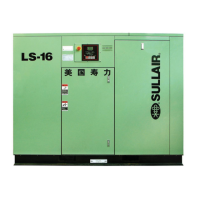Section 7
MAINTENANCE
39
2. Disconnect all piping connected tothe sumpcover
to allow removal (return lines, service lines, etc.).
3. Loosen and remove the eight (8) hex head caps-
crews (1/2--13 x 1 1/2”) from the cover plate.
4. Lift the cover plate from the sump.
5. Remove the separator element.
6. Inspect the receiver/sump tank for rust, dirt, etc.
7. Scrape the old gasket material from the cover and
flange on the sump. Be careful not to let the
scraps fall in the sump.
8. Reinsert the separator element into the sump tak-
ing care not to dent the element against the tank
opening.
9. Clean the underside of the receiver/sump tank
cover and remove any rust.
10. Replace the cover plate, washers and capscrews.
Torque to 55 ft--lbs. (75 Nm).
11. Reconnect all piping making sure return line tubes
extend to the bottom or1/4” (6mm) above the bot-
tom of the separator element. This will assure
proper fluid return flow to the compressor.
12. Clean the return line strainers before restarting
the compressor.
CONTROL SYSTEM ADJUSTMENT
Refer t o F igur e 7 -- 4. Pr ior t o adjus ting the C ontr ol
System, it is necessary to determine the desired op-
erating pressure range and also the maximum pres-
sure at which your compressor is to operate. The
pressure must not exceed the maximum operating
P/N 040694- Standard
P/N 407778- High Pressure
Figure 7-4 Pressure Switch
pressure which is stamped on the compressor serial
number nameplate. The following explanation ap-
plies to a typical installation with a desired operating
range of 115to 125psig(7.9 to 8.6bar). This informa-
tion will apply to a compressor with any other operat-
ing range excepting the stated pressures.
Remove the cover of the pressure switch. With the
shut--off valve closed (or slightly cracked open) start
the compressor. Observe the line pressure gauge
and pressure switch contacts. When the line pres-
sure reaches 125 psig (8.6 bar), the pressure switch
contacts should open. If the pressure switch con-
tacts do not open or they open prior to the desired
pressure, the pressure switch setting will require ad-
jus t ment ( r efer t o F igur e 7 -- 4) .
FOR PRESSURE RANGE ADJUSTMENT
:
1. Remove cover to pressure switch.
2. Turn the range adjusting screw to the high pres-
sure setting. Turning the screw counterclockwise
lowers both the high and low pressure equally.
FOR DIFFERENTIAL ADJUSTMENT:
Differential is the difference between the high and
low pressure settings. 10 psig (0.7 bar) is typical.
1. Turn the differential adjusting screw to the lower
(reset) setting. Turning the screw counterclock-
wise widens the differential by lowering the reset
(lower) setting only.
2. When the pressureswitch adjustment is complete,
the pressure regulator should be adjusted for the
pressure at which modulation of air delivery
should begin. In this case that pressure will be
118 psig (8.2 bar). The regulator is adjusted by
loosening the jam nut on the end of the cone
shaped cover of the pressure regulator. When the
jam nut is loose, turn the adjusting screw clock-
wise to increase or counterclockwise to decrease
the setting.
3. To set the regulator, continue closing the service
valve until the line pressure is 118 psig (8.2 bar).
At this point regulator should pass a signal to the
inlet valve to start closing it. If the line pressure
keeps on rising or if the modulation does not be-
gin, adjust the regulator valve as described
above. After adjustment, line pressure should be
approximately 118 psig (8.2 bar) and 1.00 in. Hg
(2.54 cm Hg.) vacuum below the inlet.
4. Next, close the service valve; line pressure will
start rising. When line pressure reaches 125 psig
(8.6 bar), the inlet valve will be closed to its maxi-
mum position. The inlet vacuum at this point will
be around 25 in. Hg (63.5 cm Hg.). The machine
should unload at this point.
5. Open the service valve so the line pressure is 115
psig (7.9 bar). Machine is now set for operation.
Recheck the unload pressure by closing of the
service valve. Machine should unload via the
pressure switch at 125 psig (8.6 bar).
After the control pressures have been adjusted, the
“unloaded” sump pressure should be checked. It will

